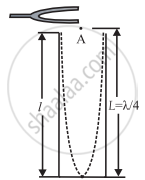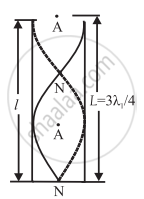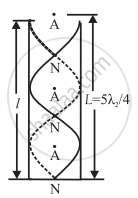Advertisements
Advertisements
Question
Show that only odd harmonics are present in an air column vibrating in a pipe closed at one end.
Solution
Consider a narrow cylindrical pipe of length l that is closed at one end. When sound waves are sent down the air column in a cylindrical pipe that is closed at one end, they are reflected at the closed end with a phase reversal and at the open end without a phase reversal. Interference between incident and reflected waves creates stationary waves in the air column under the right conditions.
In this situation, stationary waves in the air column must satisfy two boundary conditions: a node at the closed end and an antinode at the open end.
The resonating length of the air column is L = l + e, taking into account the end correction c at the open end.
The first mode of vibrations of air column closed at one end is as shown in Figure.

Let v be the speed of sound in air. This is the simplest mode of vibration of air column closed at one end and an antinode at the open end. The distance between a node and a subsequent antinode is equal to `λ/4`, where λ is the sound wavelength. The wavelength λ and frequency n are
∴ Length of air column: L = `λ/4` and λ = 4L
If n is the fundamental frequency, we have,
v = nλ
∴ n = `v/λ = v/(4L) = v/(4(l + e))`
The fundamental frequency is also known as the first harmonic.
In the second mode of vibration of the air column, two nodes and two antinodes are formed. If n1 is the frequency and λ1 is the wavelength of wave in this mode of vibrations in air column, we have,

The length of the air column, L = `(3λ_1)/4`
The velocity in the second mode is given as v = n1λ1.
∴ n = `v/λ_1 = (3v)/(4L) = (3v)/(4(l + e))`
This frequency is called the third harmonics or first overtone. Similarly, during the third mode of vibration of the air column, three nodes and three antinodes are formed.
The next higher mode of vibrations of air column closed at one end is as shown in Figure.

Here the same air column is made to vibrate in such a way that it contains a node at the closed end, an antinode at the open end with two more nodes and antinodes in between. If n2 is the frequency and λ2 is the wavelength of the wave in this mode of vibrations in air column, we have
The length of the air column, L = `(5λ_2)/4`
∴ λ2 = `(4L)/5`
`n_2 = v/λ_2 ="5v"/(4L)=(5"v")/(4(l + e))=5"n"`
This frequency is called the fifth harmonic or second overtone.
Thus, we see that the frequencies of the modes of vibrations are in the ratio n: n1: n2 = 1: 3: 5. This shows that only odd harmonics are present in the modes of vibrations of the air column closed at one end.
APPEARS IN
RELATED QUESTIONS
What are the forced vibrations and resonance?
Distinguish between forced vibrations and resonance.
Differentiate between free and forced vibrations.
A sonometer wire vibrates with three nodes and two antinodes, the corresponding mode of vibration is ...................
a) First overtone
b) Second overtone
c) Third overtane
d) Fourth overtone
A stretched wire emits a fundamental note of frequency 256 Hz. Keeping the stretching force constant and reducing the length of wire by 10 cm, the frequency becomes 320 Hz. Calculate the original length of wire.
State law of length.
What are forced vibrations?
Show that even as well as odd harmonics are present as an overtone in modes of vibration of the string.
A stretched wire 60 cm long is vibrating with its fundamental frequency of 256 Hz. If the length of the wire is decreased to 15 cm and the tension remains the same. Then the fundamental freuqency of the vibration of the wire will be ______.
